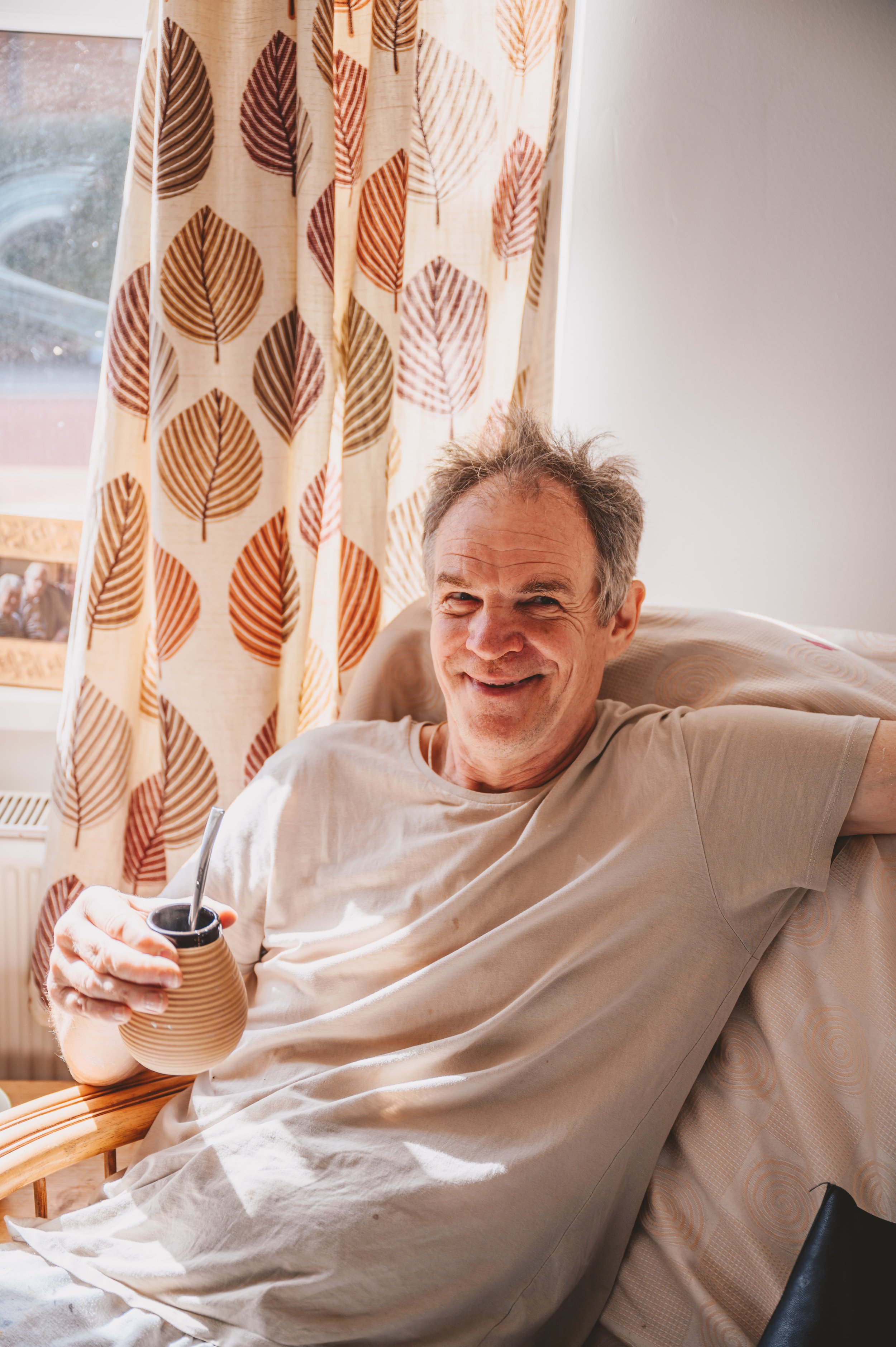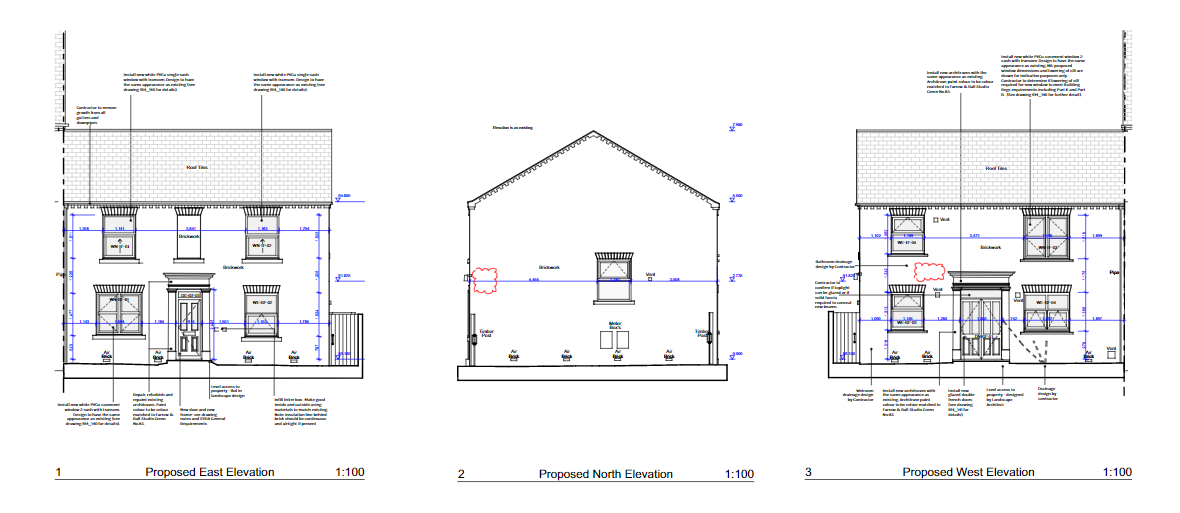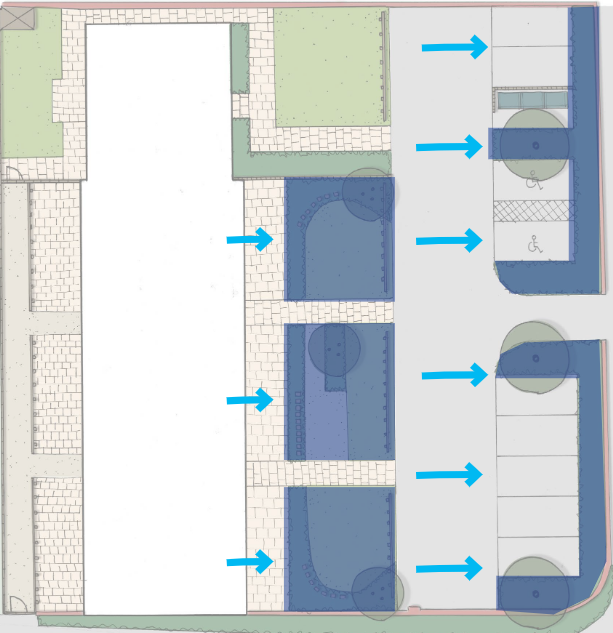Celebrating South Yorkshire Housing Association at 50: and only two Chief Executives in 50 years
Gell Street refurbishment: celebrating Tony Stacey’s contribution as Chief Executive over the last 27 years
Project date: 2022
Team:
South Yorkshire Housing Association, Client – Gareth Wallace-Parkin, Neil Whitaker, Kemba Mitchell
RF Joinery, Contractor (main block) –Ray Fowler
Bauman Lyons, Architects (house) –Christie-Lee McAreavey
93ft, Interior Design –Claire Timpani
Arup, Landscape Architects – Zac Tudor, Sam Slinn
South Yorkshire Housing Association is 50 this year.
Founded in 1972 in the wake of Cathy Come Home, Ken Loach’s ground-breaking film about family homelessness, we can trace a clear line of sight to our origins when John Belcher established the association from a phone box in Sheffield.
Since then we have grown to an organisation of 6000 homes, serving 25,000 customers a year across a wide range of housing, care, health and employment services across South Yorkshire. But, unlike many associations, we have never lost sight of our mission to prevent and address homelessness.
How have we managed to stay true to our founder’s mission?
Part of the answer lies in the consistency of our leadership: we have had only two Chief Executives in our 50-year history, John Belcher and Tony Stacey. It is also because of the quality of those two leaders and their commitment to our purpose.
Tony has announced his imminent, and well-deserved, retirement after 27 years. This blog uses the refurbishment of a former homeless hostel to tell the story of Tony’s contribution to South Yorkshire Housing Association.
Our 50th anniversary celebrations have been characteristically modest and respectful of our customers and our purpose.
JULIANN HALL’S 50TH ANNIVERSARY CAKES, BAKED FOR OUR EMPLOYEE AWARDS EVENT
We have launched a series of podcasts and commissioned an audio piece that gives voice to our customers and our employees. Tony has written a review of his time with the association as a companion document to the one that John Belcher wrote on his retirement in 1995 that has been published on our website. We have fund-raised for 50 x £50 vouchers to support our customers. And we held an awards event at our Rockingham Street office celebrating the contribution of our employees, with home-made food including plenty of cake. We are very good at cake.
And we decided to name a former hostel that we refurbished at Gell Street in Sheffield this year, John Belcher House in honour of our founder.
Why have I chosen this modest project to celebrate Tony’s contribution to South Yorkshire Housing Association?
Because it reflects his commitment to:
#1 Leadership
#2 Homelessness
#3 Racial justice
#4 South Yorkshire
#5 The Climate Emergency
The story of our Gell Street homes
South Yorkshire Housing Association is the only housing association of any size headquartered in the Sheffield City Region.
One-third of our homes, and two-thirds of our people, provide, through our LiveWell services, some form of care and support for people with additional needs including people with poor mental health, refugees, older people and people with learning disabilities. We work closely with local health and social care services and we are the biggest provider of supported housing services in our region. We work mainly in inner city areas, and have a particular focus on providing services for racially diverse and disadvantaged communities.
One of our long-standing homeless services has been housed at Gell Street for the last 30 years, in a hostel we built that comprises a block of flats and a house. It has supported over the years an incredible number of customers who have been street homeless, often with extremely complicated lives.
GELL STREET FLATS (LEFT) AND HOUSE (RIGHT)
Although the service has provided excellent support over many years, we have started to move away from large group settings to a Housing First model, the model that is now acknowledged to have the best outcomes for homeless people. Whereas in a hostel setting you receive support until you are able to move to your own tenancy, under Housing First you secure a tenancy and receive support (if you want it) in what will be your long-term home.
Group settings, like hostels, are also often based in city centres and highly visible. This makes them easy targets for, for example, drug dealers. It is easier for people to settle and achieve stability if they are living in an “ordinary” home in an “ordinary” neighbourhood close to family, friends and support networks.
We were already transitioning away from the hostel model before Covid hit. During the pandemic the health risks of group settings meant that we accelerated the move for our customers to individual homes.
As a result we were left with an empty block of flats, an empty house and a derelict garden at Gell Street. We decided to refurbish and repurpose these homes.
What can the refurbishment tell us about Tony’s time at the association?
#1 Leadership – the signage
TONY STACEY, OUR CHIEF EXECUTIVE FOR THE LAST 27 YEARS
Tony takes leadership very seriously. He has always invested in leadership development for himself and our managers. His leadership style is founded on healthy relationships and a strong sense of humility.
Tony is a fan of Jim Collins’ Good to Great.
For those of you don’t know about this seminal book on how to grow a good company into a great one, this article is a useful summary.
One of Jim Collins’s guiding principles is what he calls Level 5 Leadership.
For him the entry level, Level 1, is about being highly capable. Level 2 is about moving on a step from working as an individual to being a contributing team member. At Level 3, you progress to being a competent manager. And at Level 4 you are an effective leader who can keep your organisation performing at the highest level. Sounds like the pinnacle? Not for Jim Collins.
For Jim Collins Level 5 leadership is about “a paradoxical combination of personal humility plus professional will”. It is that combination that moves a company from good to great. The best Chief Executives have a highly developed sense of humility.
Tony is probably the most humble leader I know. He has an incredible commitment to self-improvement: even in his twilight weeks as Chief Executive he still asks for feedback, he still takes advice from the people around him, he still seeks to serve.
The refurbishment of the Gell Street block of flats was completed early in 2022. Naming the building felt like a good opportunity to celebrate our 50th anniversary. No way would Tony have let us name it after him! (It goes without saying that he will hate this blog…)
GELL STREET FLATS REFURBISHED IN 2022 FOR KEYWORKERS AND OTHERS IN HOUSING NEED
So we have called it John Belcher House, in honour of our founder.
We never label our homes with our brand: we believe strongly that our customers “own” our homes. Instead we have at Gell Street installed a low-key and dignified reference to our first Chief Executive.
#2 Homelessness – the flats
TONY (LEFT) AGED 10
Tony often tells the story that when he was 10 years old he saw Ken Loach’s film, Cathy Come Home, and decided there and then he wanted to work in social housing. He has never wavered from that decision.
I find it incredible that a person could have such conviction about their future career at such a young age and then stick to it for his whole working life.
And it’s not just social housing of course. Tony’s passion is homelessness.
JOHN BELCHER (LEFT), ONE OF ONLY TWO CHIEF EXECUTIVES AT SOUTH YORKSHIRE HOUSING ASSOCIATION IN OUR 50 YEAR HISTORY
It might sound obvious that a housing association would be committed to homelessness. But many associations swerve the challenges of housing people who have experienced homelessness in all its different forms.
John Belcher established South Yorkshire Housing Association 50 years ago, in the wake of Cathy Come Home, to address family homelessness. 50 years later our homeless services are still core to our purpose and business, and going from strength to strength.
GELL STREET FLATS - KITCHEN
GELL STREET FLATS - LIVING ROOM
We have converted the main block at Gell Street to self-contained apartments serving key workers and others in housing need. It’s in a great city centre location, close to the big hospitals and other public services. It’s lovey to see our customers so settled already.
GELL STREET FLATS - JOHN ALREADY LOOKS VERY AT HOME!
#3 Racial justice – the house
OUR FIRST RACE ACTION PLAN
Tony is deeply committed to addressing racial injustice.
In 2020 in the wake of the death of George Floyd, like many organisations, we felt the need to face up to our own contribution to racial injustice. And we knew we needed to do some deep work work both to understand the issues around race in our business and to decide what action we could take to address these.
With racially and ethnically diverse colleagues across our organisation Juliann Hall, our Co-Director of care, Health & Wellbeing, led a year-long piece of co-design work to develop our first Race Action Plan. The approach has since been recognised as an example of good practice across the housing sector and beyond. Tony was key to driving this work and spent a year working with the co-design group to support the development of the Race Action Plan. He has since used his regional and national profile to disseminate it widely.
Tony often says that the single project he is most proud of in his 27 years’ tenure, is Safe Haven Yorkshire. For 6 years South Yorkshire Housing Association, in partnership with Yorkshire Housing, ran on behalf of the Home Office the housing and support service for all of the asylum seekers in Yorkshire and the Humber. At its peak the service provided support for 3000 people and employed 175 people, half of whom were from racially and ethnicaly diverse communities.
Alongside the main block of flats at Gell Street there is a smaller house, formerly used as a shared house. We have decided to convert it to a four-bedroom multi-generational family home.
GELL STREET HOUSE - ELEVATIONS
There is high need and demand for large homes for affordable rent in or near the city centre. Only one such home was available to let in this part of the city in 2020/21; it received 131 bids. Large homes for affordable rent are expensive to deliver, hence the shortage, and so we are taking this opportunity through converting an existing building to add new supply in a cost-effective way.
The association has had a long-term commitment to delivering four+ bedroom homes for rent and already manages 24% of the existing affordable rent homes of this size in the city. This is an one example of action we are taking as part of our Race Action Plan.
When the Gell Street house became empty, we needed to do some detailed design work to convert it to a large family home. Securing all the necessary approvals meant the home was due to be empty for many months. We worked in partnership with ASSIST, a Sheffield based charity that supports people with no recourse to public funds, to secure funding from Crisis to deliver a project to use void properties as accommodation for people seeking asylum. We have close links to ASSIST (Juliann is a former Chair) and are delighted to be able to support the fantastic work they do.
GELL STREET HOUSE - GROUND FLOOR PLAN
GELL STREET HOUSE - FIRST FLOOR PLAN
The conversion from a shared house to a large family home will remove institutional fire doors and compartmentalisation to create a four bedroom/eight person home that is designed with our racially and ethnically diverse customers in mind.
An enclosed entrance hallway means that outside shoes and clothes can be kept separate from the living space, which is often also used for prayer. The toilets do not face the qibla. The kitchen/dining room is separate from the living room which allows for separate spaces for cooking and socialising, and gender-segregated spaces for celebration and other events. The ground floor is fully accessible, with a bedroom and wet room to accommodate older family members.
We are close to instructing the works to this building which will be ready to let early in 2023.
#4 South Yorkshire – the interior design
Tony is committed to “place” and was for five years Chair of Placeshapers, a national network of locally-based, people-focused housing associations.
Not for nothing have we stuck with our name through several re-brands – we are the South Yorkshire Housing Association. We have also stuck to our geography, despite being tempted on occasion to expand.
This hasn’t in any way limited our ambitions or impact: Tony is rightly proud that he can say South Yorkshire Housing Association is a local organisation with national influence.
I have written elsewhere about how our brand references the landscape and colour palette of South Yorkshire, as well as local materials and products. It is expressed in everything we do including the design of our homes.
Through remodelling our workspaces we have developed an interior design language that supports our brand. And we have started to think about how the interiors of our homes can reflect this brand.
In general, in the private spaces (flats and houses) we want the design to be contemporary but neutral: this is not “our” space, it’s space for our customers to personalise. But in shared spaces we want to bring a layer of character and consistency (not uniformity) that reflects our brand.
Gell Street is the first interior where we have tried this approach.
We co-designed the look and feel of our new interiors with our customers.
“It’s about first impressions, and thereafter, coming home.”
“It should be bright, welcoming and homely.”
93ft, our interior designers, in response wanted the design to feel welcoming, accessible, warm, homely and thoughtful. A million miles away from the institutional feel of the previous hostel.
We have chosen a simple palette, using the greens that speak to the hills, woods and valleys of Sheffield, which is officially the greenest city in the UK. We have kept the stairwell light and airy, with darker flooring and paintwork at thresholds where there will be most use.
THE STAIRWELL IS LIGHT, AIRY AND GREEN
A NEW TIMBER HANDRAIL, COMFORTABLE TO HOLD
SMART BUT INEXPENSIVE TOUCHES
We like timber for its low carbon credentials. And we have lots of trees in Sheffield. We have added a new timber handrail, comfortable to hold, on the wall.
We originally felt that the wired glass was a bit institutional and should be replaced with clear. But apparently wired glass is now very fashionable (who knew?) so we retained it, saving on cost as well as carbon.
The door furniture and lighting is deliberately smart and contemporary, the kind you would expect in a city centre apartment block.
In Gell Street house we will also be trialling our new kitchen and bathroom specification. For the same budget as the old specification, we have tweaked the details to create a simple and elegant look, that won’t date.
Small changes to flooring, tiling, lighting, ironmongery, kitchen units and surfaces, along with different fixtures and fittings, have made a big difference.
As with our workspace, all the elements are robust and practical, never extravagant. And they demonstrate our commitment to quality and sustainability.
#5 The climate emergency – the garden
OUR WELCOME PACK INCLUDES GUIDANCE ON KEEPING BILLS AND CARBON DOWN
Tony often says that we will be judged in 50 years’ time not by our homes or services but by our response to the climate emergency.
He has chaired our Sustainability Steering Group since its inception and has been a strong advocate for decarbonisation of our homes and business operations. He has also worked closely with the regional Together with Tenants group to explore effective ways of having this conversation with our customers.
Refurbishing both the flats and the house at Gell Street is in itself sustainable: the greenest buildings are the ones that already exist. And we have taken the opportunity to improve the building fabric where we can.
The next step is to transform the garden and car park. The homes are directly opposite a park and primary school and next door to one of Sheffield’s few remaining Georgian terraces.
Our site hasn’t been a particularly good neighbour in the past and we want to change that by remodelling the car park and garden to make a positive contribution to the wider neighbourhood.
GELL STREET FLATS FRONT ONTO THE CAR PARK AND SHARED GARDEN
And because the site is in Sheffield city centre, we have decided to develop a garden based on the Grey to Green planting and SuDS scheme that has become a hallmark of the city’s public realm.
Zac Tudor, who led the design of the public realm in the city centre over recent years, has moved to Arup. We have appointed Zac and his team to work with us on this.
GELL STREET LANDSCAPE PLAN
GELL STREET SUDS SCHEME
It is a very modest scheme by Arup’s standards! But we wanted to take the opportunity to implement a sustainable scheme that could become a prototype for our new housing developments.
The design formalises the car parking: we will be able to generate income from these spaces which we can reinvest. And it creates a shared garden for the flats and a family garden for the house.
GELL STREET LANDSCAPE MATERIALS
The boundaries and bin store are brick and – you guessed it – timber. The paving materials are simple. Street trees define the frontage, in keeping with the mature trees of the Georgian streetscape. Smaller trees and ornamental planting frame the garden spaces.
Across the whole space surface water drains into the planting beds, creating the opportunity for sustainable urban drainage, reducing the water run-off that goes into the sewer systems. Water run-off from roads and parking that goes into sewers contributes 25% of the micro plastics into our oceans. This is a small step to help combat water pollution.
South Yorkshire Housing Association is 50 years old!
When John Belcher retired from the association he wrote a history of its first 23 years. Tony, on the verge of retirement after 27 years, has written a companion piece for our 50th anniversary.
You can read that piece on our website: South Yorkshire Housing Association, the first 50 years.
























